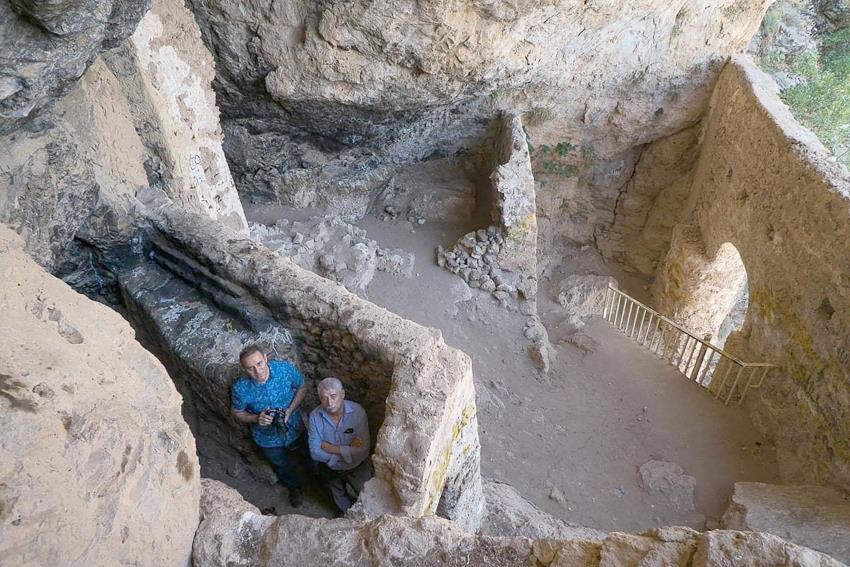
Since antiquity, the Kurdistan Region has been the center of religious and ethnic coexistence.There are several villages, districts, towns and cities in the Kurdistan Region where Muslims and Christians or Muslims and Yazidis or Muslims, Yazidis and Christians dwell side by side.Furthermore, they have joint shrines. In other words, Muslims and Christians both agree that such shrines are holy; therefore, they visit the same shrines at separate times.
Raban Boya’s Location
The Shrine of Raban Boya, also known as Raban Beri or Wisu Rahman, is located in Shaqlawa, a resort town in Erbil governorate. It is situated in a valley at the skirts of Safin Mountain Range, overlooking Shaqlawa. The shrine is more than 2km away from the nearest major road. Half of the path to the shrine has been constructed and asphalted by the Kurdistan Regional Government (KRG), leaving only 30 minutes of walking for the visitors. As a ritual, people walk to the shrine. Half the pedestrian path is paved with stairs; the rest is steep and swirling. The shrine is to the right of the road, connecting the Sarmaydan neighborhood in Shaqlawa to the upper part of the town and stretching further to the Hiran township at the foot of Safin Mountain. The shrine is 40km away from central Erbil.
The Structure of the Shrine
The shrine is located in a valley inside a cave high in the mountain. It’s 20 meters higher than its surrounding areas. So, stairs are built to lead up to the shrine. Some 30 meters away from the mouth of the cave, there is a seven-meter-deep water well dug in the rocks. It was built for storing water and served as a source of water. Moving up the stairs and arriving at the cave, the visitors face an ancient 5X6 meter rock and plaster erected wall that blocks the mouth of the cave. Therefore, an arched-shaped gate to enter the cave is constructed. Walls inside divide the cave into three parts (rooms). Each room hosts a different ceremony. The first part resembles a reception hall. There is a stone called Bardi Mirazan, which is 3x4 meters in size and has a sloping position. Tourists lean down on the stone on their stomachs, praying God for their wishes, especially for having children. It’s believed that if the head of the person touches the ground, their wish will come true. Small stones are thrown backward into a high hole in the second part of the cave, which is 4 meters deep. It is believed that if the stone falls into the hole, the wish of the person throwing it will come true. The third room contains a grave which is thought to belong to Raban Boya.
Who Is Raban Boya and Why He Is Holy?
The cave bears signs of human intervention, suggesting deliberate expansion over time. While precise historical records regarding the shrine are lacking, local lore offers intriguing accounts of its origins. According to one narrative, the cave served as a place of worship for a Christian saint known as Raban Boya, who is said to have frequented the site during the third century AD. Conversely, Muslims in the region believe that the saint, known as Wisu Rahman, was actually a follower of Islam. Adding to the mystery, some speculate that the cave may have originally functioned as a Zoroastrian temple.
Despite the ambiguity surrounding its history, certain Christian clerics assert that the shrine's origins can be traced back to the third century BC. Regardless of its exact inception, the shrine holds deep significance for both Muslims and Christians, who visit at different times according to their respective traditions. For Christians throughout Iraq, a particularly significant occasion occurs during the second week following Easter in April. During this time, a grand ceremony takes place, drawing thousands of worshippers, locals, tourists, and even Muslims, who come together to pay homage to the sacred site and partake in the spiritual festivities.
Travelling to the Shrine
Every year, a significant number of Christians from across Iraq and around the world visit the shrine, drawn by its sacred significance. Additionally, the location attracts tourists seeking to explore its cultural and historical heritage. The shrine sits along the route to the Jutadar Climax atop Safin Mountain, making it a popular destination for mountaineering groups. These groups, numbering between five to 10 or more weekly, are enchanted by the picturesque landscape and serene atmosphere of the valley, shrine, and surrounding mountain slopes.
The area also boasts the remains of an orchard, featuring a variety of fruit trees, both wild and cultivated by humans. This diverse landscape adds to the allure of the site, offering visitors a sensory experience rich with natural beauty and historical charm.
Furthermore, the vantage point of the shrine provides stunning panoramic views of the town of Shaqlawa below, adding an extra layer of fascination for tourists. The opportunity to observe the scenic town from this elevated position enhances the appeal of the religious site, contributing to its popularity among travelers seeking both spiritual and recreational experiences.
Sources consulted for this article:
Rosti, N. (2011) A Trip to Tourism, Erbil: Roksana.
https://sites.google.com/site/awladalshohadaa/1/a1/der-al-raban-
Written by: Nadir Rusti
Translated by:
Leyla Hamid
Read 88 times